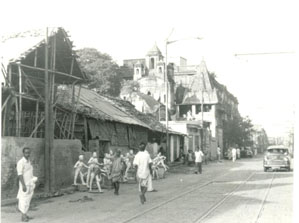

The traditional centres of clay image making are Kumartuli in Calcutta and Krishnanagar in the Nadia district. Clay images are made for the annual Hindu festivals of West Bengal, such as Durga Puja which ends with the immersion of clay images in rivers. The tradition of clay image making in West Bengal probably has its origins in a medieval village tradition but it was during the 18th and 19th centuries that clay image making became established as the distinctive feature of Bengali culture that it is today. Wealthy Bengali families congregated in Calcutta, the trade centre for the British East India Company, and became the first major patrons for the clay image-makers.
The potters who make these images are called kumars but they often take on the surname Pal. Their work is seasonal and they have workshops where they create their images using clay from local rivers such as the Hooghly in Calcutta. Their patrons are wealthy families, individuals, clubs and businesses and they work to commission as well as selling images on the open market. Nowadays women as well as men make images.